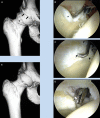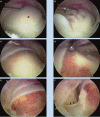Femoroacetabular Impingement in Athletes, Part II: Treatment and Outcomes
- PMID: 23015968
- PMCID: PMC3445055
- DOI: 10.1177/1941738110378987
Femoroacetabular Impingement in Athletes, Part II: Treatment and Outcomes
Abstract
Context: Femoroacetabular impingement (FAI) is a common cause of hip pathology and secondary dysfunction among athletes. Much information has been gained regarding the cause and pathomechanics of this disorder. Now, efforts are focusing on treatment to restore the joint and reduce the secondary damage that causes painful dysfunction.
Evidence acquisition: This article reviews the scientific literature in reference to treatment of FAI in athletes.
Results: Several studies reported reasonably successful outcomes in the arthroscopic management of FAI in athletes, and 1 study reported on open surgical correction of this disorder. Few major complications have been described.
Conclusions: When the diagnosis is given early, some athletes may benefit from a rehabilitation strategy that includes training modifications to protect the at-risk hip. When indicated, arthroscopic surgery can address the joint damage and correct the underlying impingement. Although the joint may not be normal, successful results with return to sports can often be expected.
Keywords: assessment; athletes; etiology; femoroacetabular impingement; hip arthroscopy.
Conflict of interest statement
One or more authors has declared a potential conflict of interest: J. W. Thomas Byrd is a consultant for Smith & Nephew and A2 Surgical and has received research funding from Smith & Nephew.
Figures






References
-
- Bizzini M, Notzli HIP, Maffiuletti NA. Femoroacetabular impingement in professional ice hockey players. a case series of five athletes after open surgical decompression of the hip. Am J Sports Med. 2007;35:1955. - PubMed
-
- Byrd JWT. Hip arthroscopy by the supine approach. Instr Course Lect. 2006;55:325-336 - PubMed
-
- Byrd JWT. Hip arthroscopy utilizing the supine position. Arthroscopy. 1994;10:275-280 - PubMed
-
- Byrd JWT. The supine approach. In: Byrd JWT, ed. Operative Hip Arthroscopy. 2nd ed. New York, NY: Springer; 2005:145-169
-
- Byrd JWT, Jones KS. Arthroscopic management of femoroacetabular impingement. Instr Course Lect. 2009;58:231-239 - PubMed
LinkOut - more resources
Full Text Sources

